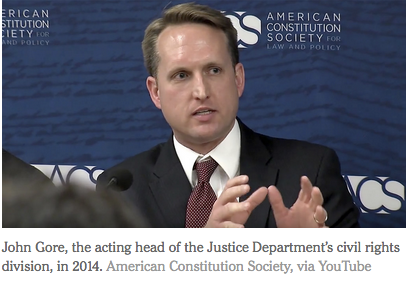WASHINGTON — The Trump administration is preparing to redirect resources of the Justice Department’s civil rights division toward investigating and suing universities over affirmative action admissions policies deemed to discriminate against white applicants, according to a document obtained by The New York Times.
The document, an internal announcement to the civil rights division, seeks current lawyers interested in working for a new project on “investigations and possible litigation related to intentional race-based discrimination in college and university admissions.”
The announcement suggests that the project will be run out of the division’s front office, where the Trump administration’s political appointees work, rather than its Educational Opportunities Section, which is run by career civil servants and normally handles work involving schools and universities.
The document does not explicitly identify whom the Justice Department considers at risk of discrimination because of affirmative action admissions policies. But the phrasing it uses, “intentional race-based discrimination,” cuts to the heart of programs designed to bring more minority students to university campuses.
Legacy Admissions: Affirmative Action for Whites
To the Editor:
Re “U.S. Rights Unit Shifts to Study Antiwhite Bias” (front page, Aug. 2):
With the Justice Department moving to challenge affirmative action in college admissions, we would do well to be mindful of important ways in which existing class and financial status benefit certain college applicants, mostly those who are white.
The simple truth is that prosperous communities, good schools and savvy guidance counselors constitute affirmative action for whites.
There is also one deliberate and robust admissions policy used at many colleges that in effect constitutes white affirmative action: That is the preference given in admissions decisions to the children of alumni of the college.
In a previous life, I was an admissions officer at Princeton. That college and others like it openly acknowledged that there was a separate pool for so-called legacies. That remains true today.
Being a legacy was no guarantee of admission. All the legacies I saw admitted were notably successful high school students and were fully capable of succeeding at a demanding college. But a significant percentage of the class was reserved for these legacies. I would say 5 to 10 percent of the admitted students were legacies who would not otherwise have been admitted.
This legacy pool has been — and remains — overwhelmingly white. It will remain so for years until the race and ethnicity of college graduates more accurately reflect those of the overall population.
Today the Justice Department would have us believe that whites face reverse discrimination in college admissions. But legacy admissions are just one example of the ways in which the college-admission competition to this day tilts white.
T. H. RAWLS, MONKTON, VT.




